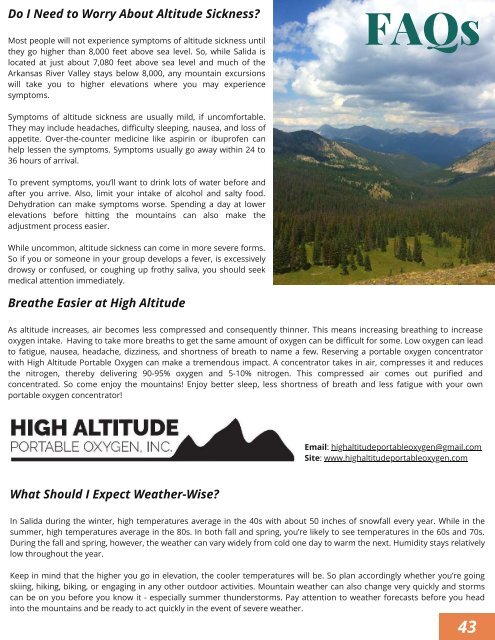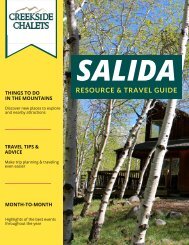Create successful ePaper yourself
Turn your PDF publications into a flip-book with our unique Google optimized e-Paper software.
Do I Need to Worry About Altitude Sickness?<br />
Most people will not experience symptoms of altitude sickness until<br />
they go higher than 8,000 feet above sea level. So, while <strong>Salida</strong> is<br />
located at just about 7,080 feet above sea level and much of the<br />
Arkansas River Valley stays below 8,000, any mountain excursions<br />
will take you to higher elevations where you may experience<br />
symptoms.<br />
FAQs<br />
Symptoms of altitude sickness are usually mild, if uncomfortable.<br />
They may include headaches, difficulty sleeping, nausea, and loss of<br />
appetite. Over-the-counter medicine like aspirin or ibuprofen can<br />
help lessen the symptoms. Symptoms usually go away within 24 to<br />
36 hours of arrival.<br />
To prevent symptoms, you’ll want to drink lots of water before and<br />
after you arrive. Also, limit your intake of alcohol and salty food.<br />
Dehydration can make symptoms worse. Spending a day at lower<br />
elevations before hitting the mountains can also make the<br />
adjustment process easier.<br />
While uncommon, altitude sickness can come in more severe forms.<br />
So if you or someone in your group develops a fever, is excessively<br />
drowsy or confused, or coughing up frothy saliva, you should seek<br />
medical attention immediately.<br />
Breathe Easier at High Altitude<br />
<br />
As altitude increases, air becomes less compressed and consequently thinner. This means increasing breathing to increase<br />
oxygen intake. Having to take more breaths to get the same amount of oxygen can be difficult for some. Low oxygen can lead<br />
to fatigue, nausea, headache, dizziness, and shortness of breath to name a few. Reserving a portable oxygen concentrator<br />
with High Altitude Portable Oxygen can make a tremendous impact. A concentrator takes in air, compresses it and reduces<br />
the nitrogen, thereby delivering 90-95% oxygen and 5-10% nitrogen. This compressed air comes out purified and<br />
concentrated. So come enjoy the mountains! Enjoy better sleep, less shortness of breath and less fatigue with your own<br />
portable oxygen concentrator!<br />
Email: highaltitudeportableoxygen@gmail.com<br />
Site: www.highaltitudeportableoxygen.com<br />
What Should I Expect Weather-Wise?<br />
<br />
In <strong>Salida</strong> during the winter, high temperatures average in the 40s with about 50 inches of snowfall every year. While in the<br />
summer, high temperatures average in the 80s. In both fall and spring, you’re likely to see temperatures in the 60s and 70s.<br />
During the fall and spring, however, the weather can vary widely from cold one day to warm the next. Humidity stays relatively<br />
low throughout the year.<br />
Keep in mind that the higher you go in elevation, the cooler temperatures will be. So plan accordingly whether you’re going<br />
skiing, hiking, biking, or engaging in any other outdoor activities. Mountain weather can also change very quickly and storms<br />
can be on you before you know it - especially summer thunderstorms. Pay attention to weather forecasts before you head<br />
into the mountains and be ready to act quickly in the event of severe weather.<br />
43










